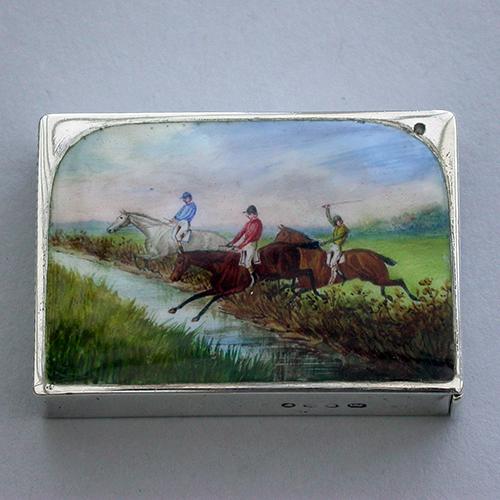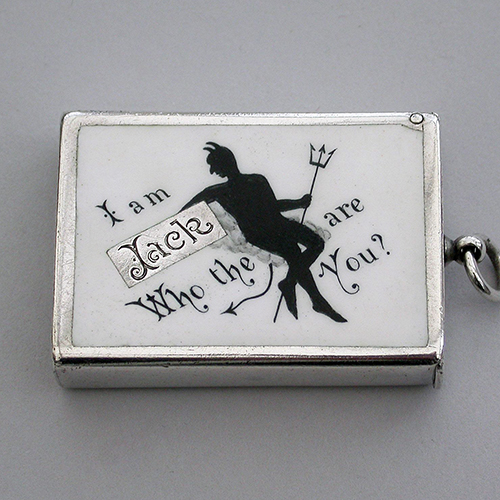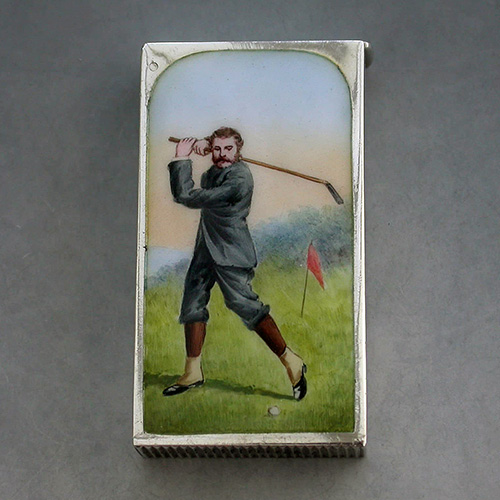

With grateful thanks to BADA member David Buck of Steppes Hill Farm Antiques.
The vesta case or match safe as they are known in the US, is a small pocket-sized receptacle designed specifically for carrying friction matches. First invented by the English chemist John Walker in 1826, friction matches could ignite accidentally when carried loosely so the vesta case quickly became an everyday essential.
Their name derives from a particular brand of match called the ‘wax vesta’ which was first patented by fellow Englishman William Newton in 1832. Newton named his incendiary invention after the ancient Roman deity Vesta, goddess of hearth, home, and family, and the name was widely adopted as all-encompassing term for matches.
Vesta cases were produced in a wide variety of materials from silver, gold, brass, and tin, to ivory, tortoiseshell, horn, and bone. Designs were equally diverse with cases taking the form of animals, boots, books, musical instruments and just about any conceivable household object or hobby.
Perhaps the most creative variation in design is the enamel vesta case which remain amongst the most collectable of cases to this day. It wasn't until the late 19th century that directly applied enamel painting began to appear on pocket vesta cases. It soon became hugely popular, and the brightly coloured enamels adorn some of the finest and most sought-after examples.
 Something of a fashion accessory for the well-heeled gentleman, hand painted, and expensive enamelled examples were an indication of one’s affluence and good taste. The vesta case would be displayed attached to a swivel clip on one end of an 'Albert' watch chain or carried loose in the waistcoat pocket.
Something of a fashion accessory for the well-heeled gentleman, hand painted, and expensive enamelled examples were an indication of one’s affluence and good taste. The vesta case would be displayed attached to a swivel clip on one end of an 'Albert' watch chain or carried loose in the waistcoat pocket.
Creating a 'picture vesta' was a painstaking and skilful operation. The surface area of the silver would be cut out and then filled with a neutral opaque enamel and fired, this would create the 'canvas'. The outline of the design would then be traced onto this surface for an enamellist to build up the image in several successive layers, each with individual colours and firings. The completed work would then be covered with a flux or clear enamel before the final firing.
Subject matter tended to be, although not exclusively, overtly masculine in taste. It was after all generally men that bought or received vesta cases as gifts. Sports and pastimes of the period tend to dominate - Hunting, Shooting, Fishing, Racing, Golf, Motoring and Sailing scenes can be found, but the female form was also popular. Gambling and Smoking themes were frequently covered, often with visual puns, double entendres or riddles. Animals, birds and insects, nautical and maritime subjects are also encountered. The list is endless!
 For practical reasons, it is not likely that any subjects were painted directly from life onto enamelled vesta cases. Instead, artists took their inspiration from existing paintings, prints, engravings, or photographs. The same subject was often reproduced multiple times, although being hand painted, no two examples are identical in every way.
For practical reasons, it is not likely that any subjects were painted directly from life onto enamelled vesta cases. Instead, artists took their inspiration from existing paintings, prints, engravings, or photographs. The same subject was often reproduced multiple times, although being hand painted, no two examples are identical in every way.
Perhaps some of the finest and most detailed work in this field was produced by the firm of Sampson Mordan & Co, based at 41 & 43 City Road, London, E.C. Their 'Flat-Top' and sentry box series depicting 'Soldiers of the Queen' being some of the most desirable.
The large premiums placed upon enamel vesta cases have seen several forgeries on the market in recent times. It pays to be aware of originally plain cases that have been 'improved' with the addition of a (usually) applied enamel plaque. The original examples generally having inset enamel.
Click here to view a selection of enamel vestas currently available from BADA members.

